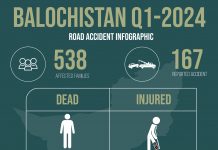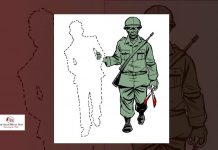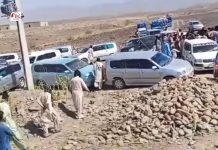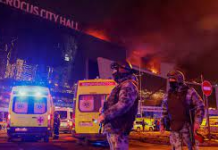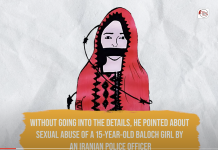Away from the media’s limelight, which is almost exclusively riveted on the political drama unfolding in Islamabad and Lahore, a wave of death and devastation has washed over Balochistan, destroying everything in its wake. The monsoon rains have wreaked havoc in the past few weeks; flash floods have inundated entire villages and displaced thousands of people; the rail, road, gas, electricity, cellular networks and bridges have been washed away, isolating Balochistan from the rest of the region. Hundreds of people, most of them women and children, have been swept away by the raging waters, and the destruction has left thousands without shelter or sustenance.
The Provincial Disaster Management Authority (PDMA) estimates that the monsoon rains and the attendant floods have killed at least 235 people in Balochistan, but the death toll is expected to be much higher as the media blackout makes it almost impossible to report anything accurately in Balochistan. Adding to that, most of the hard-hit areas are inaccessible, which makes it difficult to report the destruction unfolding there. Those who have survived the devastation are not faring any better – thousands of people are stranded in different areas of Balochistan, living under the open sky and waiting for help that may never come. The recent Met report has predicted a fresh spell of heavy rains in Balochistan, specifically in the areas that are already hard-hit. If the government does not take the necessary drastic measures to rescue the marooned families, hundreds more could die in the next wave of destruction that these rains would unleash.
The heavy rains have affected people across Pakistan, but the people in Balochistan, the poorest region with minimum infrastructure and where the majority of the people live in mud houses, have been the worst hit. The National Disaster Management Authority (NDMA) estimates that of the 36,000 houses destroyed in the region, 60% of them were in Balochistan.
According to the World Food Program, of every ten people killed in the floods in the region, three were in Balochistan, the highest toll. Thousands of acres of crops and vegetation were also destroyed, which could entail a famine in Balochistan once the rains have subsided.
Several villages in Balochistan are still cut off and unreachable, as the roads linking them to the rest of the region were washed away. Two of the most important road links that were destroyed in the floods are the RCD (Regional Cooperation Development) Highway which links Pakistan’s commercial hub Karachi to Quetta, and the Makran Coastal Highway, which links southern Balochistan, Gwadar specifically, with Karachi and the rest of Pakistan. These roads are crucial not only for travel but also for bringing food and supplies to Balochistan, and with large parts of them destroyed in multiple places, the flood-hit people confront a tenuous future.
A major railway bridge washed away between Kolpur and Mach in Bolan Pass, cutting off Quetta, the capital of Balochistan, from the rest of Pakistan for indefinite period, officials said.
The rains and floods devastating all districts of Balochistan, resulted in major food and medicine shortage. Thousands of people were forced to flee their native hometowns for safety from floods. Unfortunately, this intra-provincial migration caused a major shortage of food and medicine. Many people are left with no pure water to drink, no food to eat.
Although the rains in the last few weeks have been the worst in the three decades, the submerging or washing away of roads and bridges is nothing new. In Balochistan, the mild seasonal rains collapse bridges and wash away parts of major roads, let alone the monsoon rains and the flash floods. They are restored temporarily again and again, but no permanent solution is implemented. The problem stems from a lack of accountability at the government and the local level – the road and bridge construction projects are usually handled by corrupt local contractors, who consider these projects nothing more than a lucrative opportunity. Starting from the higher echelons of the provincial government, the funds earmarked for these projects are embezzled at every step along the way by government officials, bureaucrats and contractors, and what’s eventually left is not enough to construct quality infrastructure.
Balochistan, which receives the lowest annual rainfall in the region, is a place where dry, arid weather and droughts are normal. The rains and floods of the magnitude witnessed lately portend an alarming climate crisis. The geographical area where Balochistan falls is the eighth most affected region in the Climate Risk Index since 2000. Amid the ongoing climate crisis, the frequency of dangerous floods will likely increase. The destruction resulting from these hazards will be amplified by poverty, lack of protected housing, a disaster management system and lack of quality infrastructure. The destruction in Balochistan in the past few days proves that natural disasters become more deadly when they hit the vulnerable.
The heart-wrenching picture of Wahab Bugti, a folksinger who starred in the famed Coke Studio song ‘Kana Yari’ that has garnered millions of views on YouTube, standing beside his demolished home gives a glimpse of the miseries that the people of Balochistan face.
Unfortunately, the tale of destruction is not over – the recent forecasts by the Meteorological department predict a fresh spell of rains in the coming days. While we have been warned of unusually heavy rains, governments neither at the federal nor the provincial level have taken measures to launch a coordinated and coherent national response to cope with the challenge. While the rest of the region is submerged in muddied water, politicians and the so-called public representatives in Islamabad are focused on mud-slinging and settling political scores.
It is no secret that the drastically changing climate has put the lives of the millions of people across the world in jeopardy. Unpredictable torrential rains, prolonged droughts, climbing sea levels, rising global average temperature and melting glaciers and polar caps are only a few profound consequences of climate change. The ongoing wave of death and destruction in Balochistan serves to prove that the violent vicissitudes of climate change, compounded with extreme poverty and a lack of quality infrastructure, can leave entire populations vulnerable. Pakistan’s climate change policy does mention the need for early warning systems, evacuation plans and strategies, ensuring reconstruction of rural housing to reduce the risks of floods, and the construction of disaster-resilient hospitals, dispensaries and schools to be used as designated safe shelters.
But none of these plans were actually implemented and executed. In fact, schools were among the first buildings to collapse in the wake of the raging floods, with at least 600 schools being affected in Balochistan. The recent Met report forecasts heavy rains and possible flash floods in the coming days, and with this information in hand, the authorities are responsible for taking timely action to minimize the damage. The people living in rural settlements are not technologically advanced enough; they don’t have round-the-clock access to cable news or internet services, and they are not educated enough to make out the grim future that the weather forecasts portend. In some rural areas, residents evacuated their mud houses when they estimated possible flooding after the heavy rains continued for days. They had no place to live other than the open sky; their homes and belongings were washed away – the only thing they were left with was their lives.
The authorities need to take proactive measures to reduce the risk of such hazards to the people of Balochistan. In addition to the NDMA and the PDMA, several other government departments can help in averting the impending crisis, like those dealing with forestry, irrigation, public health and engineering, and international development organizations, such as the UNDP, the USAID and World Bank. Efficient coordination between these departments and organizations and proper planning can go a long way in averting another humanitarian crisis in Balochistan.

